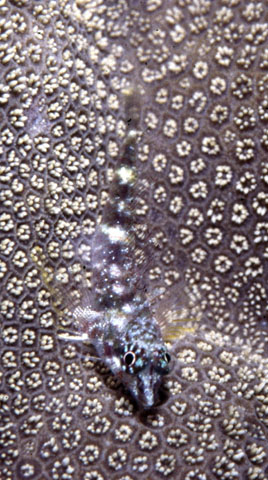| Tripterygiidae (Triplefin blennies), subfamily: Tripterygiinae |
| 2.5 cm SL (male/unsexed) |
|
reef-associated; depth range 1 - 14 m |
| Western Indian Ocean: Red Sea, along East African coast to southern Kwazulu-Natal, Mauritius, Seychelles, Comoros and St. Brandon Shoals; not recorded in Gulf of Oman. |
|
Dorsal spines (total): 14-16; Dorsal soft rays (total): 9-10; Anal spines: 1-1; Anal soft rays: 17-18; Vertebrae: 34-36. Dorsal fins III + XI-XIII + 9-10 (usually III + XII + 10); anal fin I, 17-18 (usually 18 rays); pectoral fin 15: 2-4 + 4-6 + 7 (usually 3+5+7). LL, pored scales12-14; notched scales 19-23 (usually 22-Red Sea, or 21- S. Africa east coast), starting at one scale row below the end of the pored series; longitudinal scale series 31; total lateral scales 31; transverse scales 3/6. Vertebrae 10 + 24-26. Dentary pores 3 + 1 + 3 ; head 3.2-3.8 in SL; eye 2.9-3.7 in head length; nape partially scaled, abdomen without scales, single row of scales at base of caudal fin; supratemporal sensory canal crescent-shaped; supraorbital cirrus small and pointed; first dorsal fin about equal in height to second in males, lower in females. Key features are: low first dorsal fin; brown and green radii around eye; males head and chest black, body yellow, while females body yellow-green body, head with brown stripe on nose and orange bar below eye (Ref. 57774, 88983). |
| Adults occur in shallow, sheltered waters, on hard corals; found on the upper part of coral reefs, usually along the reef margin in depths of about 1 m, often on corals covered by low algae. Also found in bays or sheltered lagoons (Ref. 88983). Eggs are hemispherical and covered with numerous sticky threads that anchor them in the algae on the nesting sites (Ref. 240). Larvae are planktonic which occur primarily in shallow, nearshore waters (Ref. 94114). |
|
(Ref. 96402)
|
| harmless |
|
Source and more info: www.fishbase.org. For personal, classroom, and other internal use only. Not for publication.
Page created by Jen, 05.08.02,
php script by kbanasihan 06/09/2010 ,
last modified by
dsantos, 20/08/10

